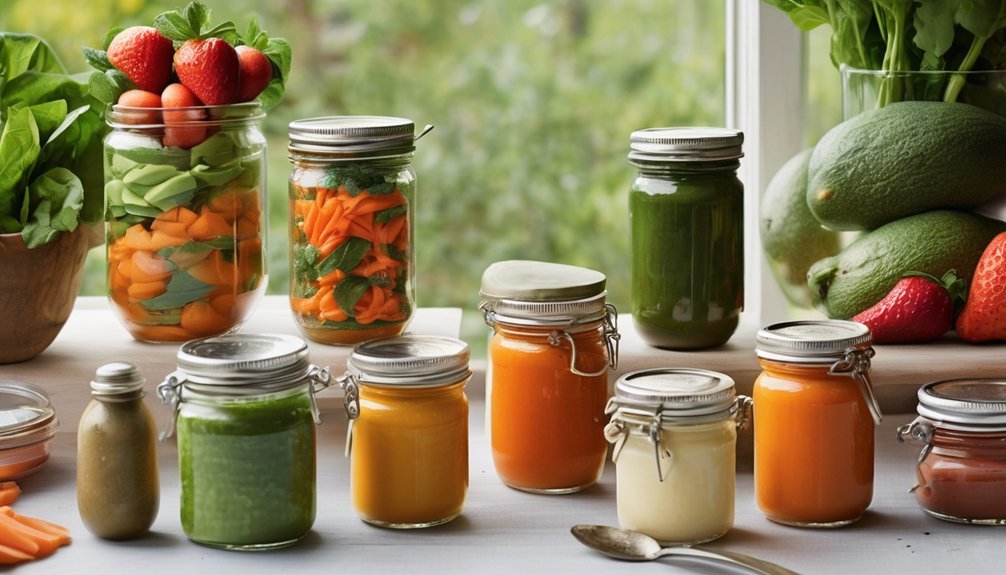Homemade Baby Food Recipes
When you choose to make homemade baby food, you’re opting for meals that are fresh and tailored to your baby’s nutritional needs. Simple purees can introduce your little one to a variety of flavors while ensuring the quality of ingredients. You’ll find that starting with single-ingredient fruits and vegetables provides a solid foundation. As you progress, you can explore mixing flavors and textures, but understanding the essentials is key to a successful transition.
Key Takeaways
- Start with simple purees like sweet potatoes or carrots to introduce essential nutrients and flavors to your baby.
- Use a reliable blender to achieve smooth textures, essential for early stages of baby food.
- Freeze homemade purees in ice cube trays for easy portioning and storage, lasting up to three months.
- Gradually introduce new foods one at a time to monitor for allergies or intolerances effectively.
- Incorporate a variety of colors and textures to make mealtime engaging and promote healthy eating habits.
Benefits of Homemade Baby Food
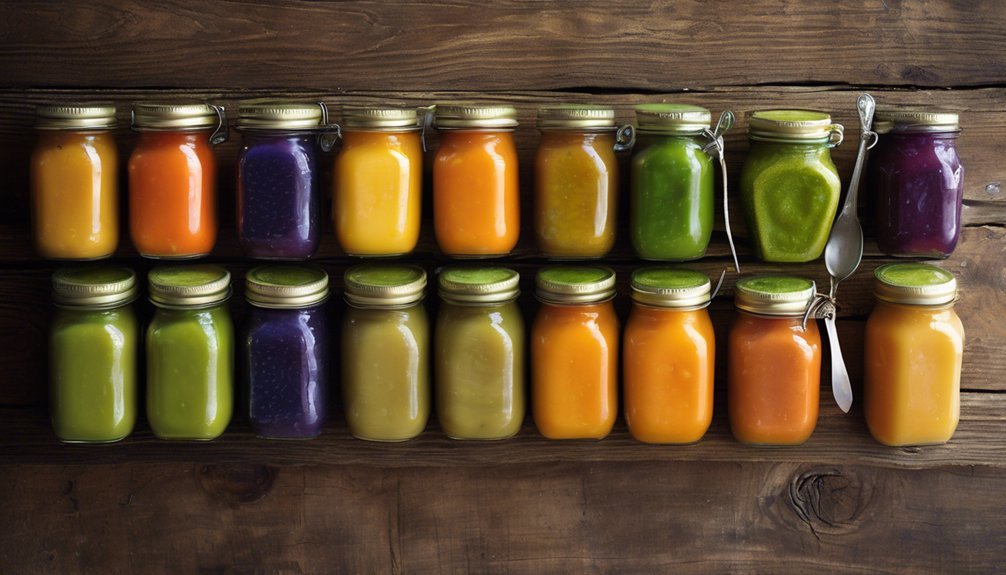
When you choose to make homemade baby food, you’re not just providing your little one with nourishment; you’re also ensuring they receive fresh, wholesome ingredients tailored to their specific needs.
By preparing baby food at home, you gain nutritional control over what your child eats, allowing you to select organic fruits and vegetables, free from preservatives and artificial additives. This approach supports your baby’s health while introducing them to a variety of flavors and textures.
Additionally, there are significant cost savings compared to store-bought options. You can often make larger batches for less money, stretching your budget while ensuring your little one enjoys nutritious meals.
Embracing homemade baby food fosters a deeper connection, as you create meals filled with love and care.
Essential Tools for Making Baby Food
To successfully make homemade baby food, you’ll need a few essential tools that streamline the process and ensure safety.
First, a reliable blender is key; consider different blender types, like immersion or countertop models, to suit your needs. A good blender helps achieve that smooth texture babies love.
Next, invest in quality food storage containers. Look for BPA-free options that are freezer-safe and easy to label, making it simple to organize your creations.
A fine mesh strainer can also be handy for achieving the perfect consistency, especially for fruits and veggies that require extra smoothing.
Lastly, don’t forget a sturdy cutting board and a sharp knife for prepping ingredients.
With these tools, you’re ready to create nutritious meals for your little one!
First Foods: What to Start With
What should you consider when choosing your baby’s first foods? Start with single-grain cereals like rice or oatmeal, as they’re easy to digest and iron-fortified. You might also try pureed vegetables like sweet potatoes and carrots, which provide essential nutrients.
As you explore first food options, remember to introduce allergens like peanut butter, eggs, and fish gradually, ideally around six months. Studies show that early exposure can reduce the risk of allergies.
Always consult your pediatrician before introducing new foods to ensure they’re safe for your little one.
Finally, pay attention to your baby’s reactions, and enjoy this exciting journey of flavors and textures together. Your love and care will make this experience even more special!
Simple Pureed Fruits
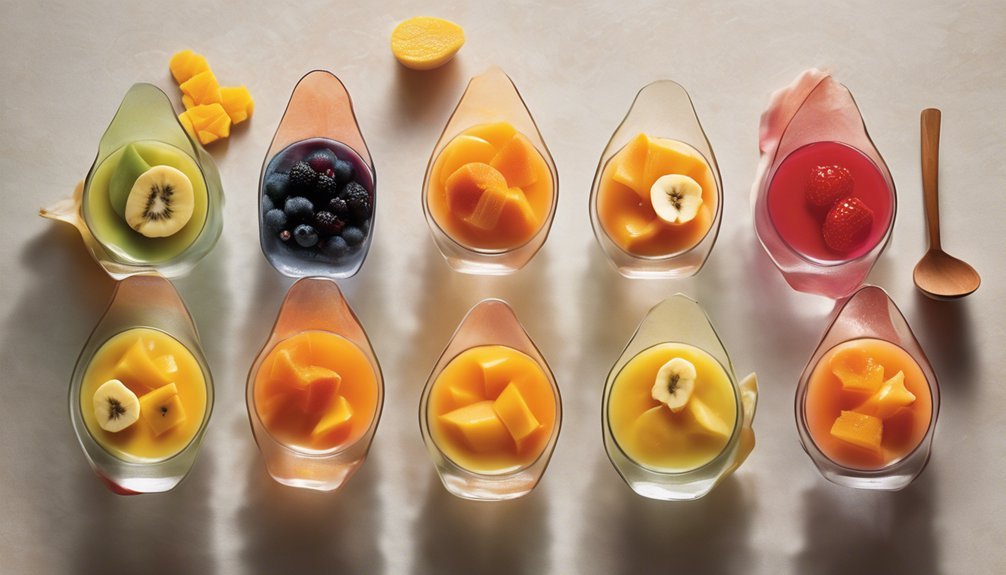
Simple pureed fruits are a delightful way to introduce your baby to new flavors while providing essential vitamins and minerals. You can easily prepare banana puree by mashing ripe bananas until smooth, offering a creamy texture that’s easy for your little one to enjoy. This fruit is rich in potassium and fiber, promoting healthy digestion.
Another favorite is apple sauce, which you can make by cooking peeled apples until soft and blending them into a smooth consistency. Apples are packed with vitamin C and antioxidants, making them a nutritious choice.
Both of these purees can be served alone or mixed for added variety, allowing your baby to explore different tastes while you bond over mealtime.
Nutritious Vegetable Mash
When you introduce nutritious vegetable mash to your baby’s diet, you’re providing a wonderful opportunity for them to experience a variety of flavors and textures.
Start with nutrient-rich vegetables like sweet potatoes, carrots, and peas, which are packed with vitamins and minerals essential for your baby’s growth. To prepare the mash, steam or boil these vegetables until they’re tender—these ideal cooking methods help retain their nutrients.
Once cooked, blend or mash them to your desired consistency. You can even mix different vegetables for added taste and nutrition.
Hearty Grain Options
After introducing your baby to nutritious vegetable mash, it’s a great time to explore hearty grain options that can complement those flavors and provide important carbohydrates for energy. Oatmeal recipes are a fantastic choice; they’re rich in fiber and can be mixed with fruits or veggies for added taste. Quinoa blends are another wonderful option, offering a complete protein source and a nutty flavor.
Here’s a quick reference table to inspire your meals:
| Grain Type | Suggested Mix-ins | Cooking Method |
|---|---|---|
| Oatmeal | Apples, Cinnamon | Boil and Mash |
| Quinoa | Carrots, Peas | Cook and Blend |
| Barley | Sweet Potatoes | Simmer and Mash |
These grains will keep your little one satisfied and energized!
Blended Meat and Protein Sources
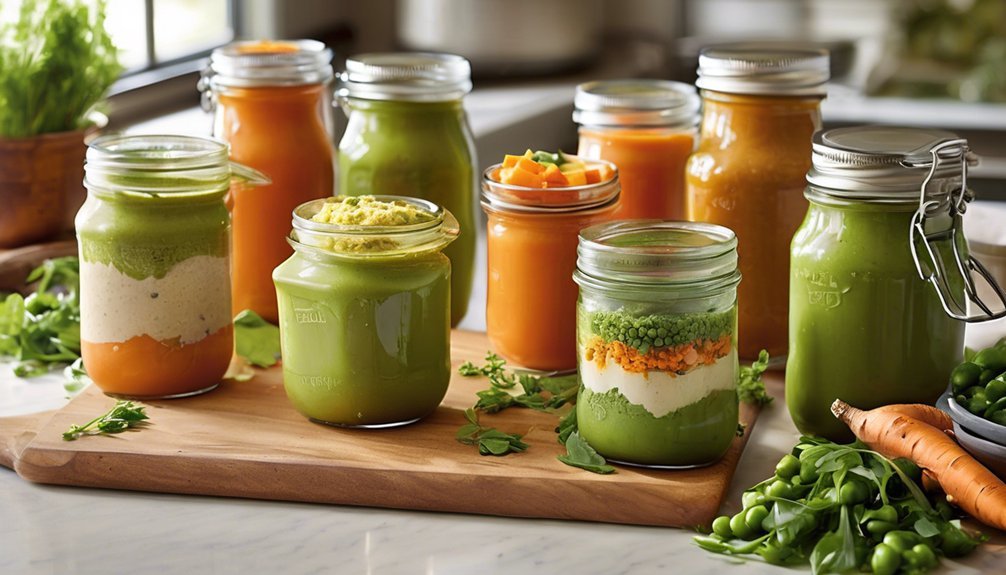
Introducing blended meats and protein sources into your baby’s diet around six to eight months is essential for their growth and development. At this stage, your little one needs iron and protein to support their rapidly growing bodies.
You can start with finely blended chicken, turkey, or beef, ensuring they’re cooked thoroughly and pureed to a smooth consistency. Adding cooked lentils or beans can also provide valuable protein sources.
Mix these meats with vegetables or fruits to enhance flavor and nutrient absorption. Always check for any signs of allergies and consult your pediatrician before introducing new foods.
Flavorful Bean Purees
While your baby explores new flavors, flavorful bean purees are a fantastic way to introduce essential nutrients like protein and fiber. Beans come in various types, such as black, kidney, and pinto, each offering unique tastes and textures.
You can create delightful flavor combinations by mixing beans with ingredients like mild garlic, a hint of cumin, or even a splash of lemon juice. These additions not only enhance the taste but also introduce your little one to a world of culinary experiences.
To prepare, simply cook the beans until soft, then blend them until smooth. This approach ensures your baby gets a nutritious meal while developing a palate for diverse flavors.
Enjoy this bonding experience as you nourish your child!
Combining Flavors: Fruit and Veggie Mixes
Combining fruits and vegetables in homemade baby food opens up a world of flavors and nutrients for your little one. By experimenting with various fruit combinations and veggie pairings, you can create delicious purees that delight their taste buds while providing essential vitamins and minerals.
For instance, mixing sweet peas with ripe avocado offers healthy fats and fiber, while blending apples with carrots introduces a sweet, vibrant taste. Consider adding a pinch of cinnamon to pear and sweet potato for a comforting twist.
These combinations not only enhance taste but also encourage your baby to embrace a variety of textures and flavors, setting the foundation for healthy eating habits. Enjoy the process—it’s a wonderful bonding experience!
Freezing and Storing Baby Food
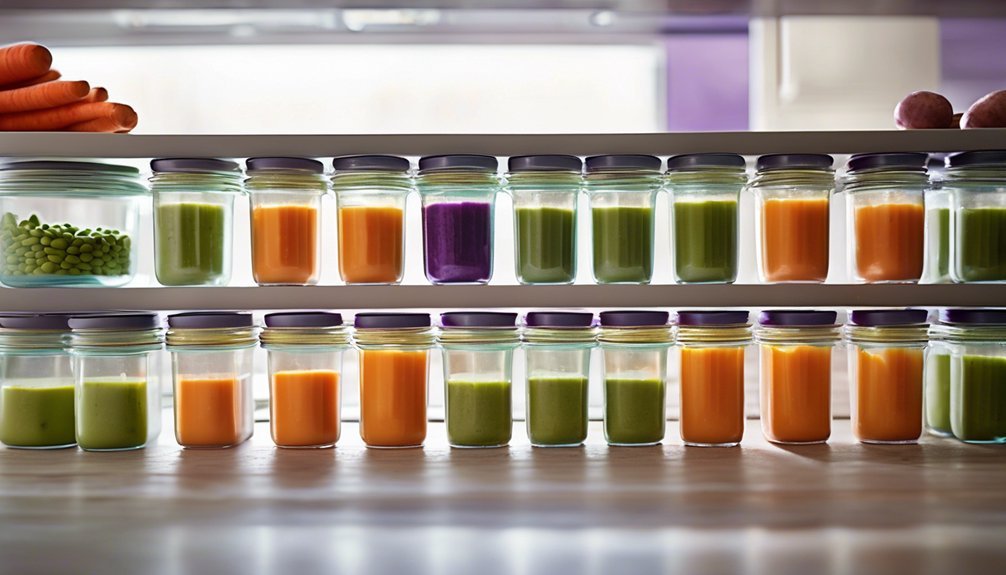
After creating delicious fruit and veggie mixes for your baby, knowing how to properly freeze and store these homemade purees is vital for maintaining their freshness and nutritional value.
Start by using ice cube trays for easy portioning—just fill each compartment with the puree and freeze until solid. Once frozen, transfer the cubes into labeled freezer bags to ensure food safety; they can last up to three months. Remember to squeeze out excess air before sealing.
When you’re ready to serve, thaw the desired amount in the refrigerator or warm it gently in a bowl of hot water. Always check the temperature before feeding, ensuring it’s safe for your little one.
Enjoy stress-free mealtime!
Transitioning to Chunky Textures
As your baby grows and develops, you’ll want to transition to chunkier textures to encourage chewing and enhance their eating skills.
This texture progression is essential for developing oral motor skills and helping your little one learn to manage different food consistencies. Start by introducing small, soft pieces of cooked vegetables or ripe fruits, ensuring they’re appropriately sized to reduce choking hazards.
Always prioritize baby food safety; keep an eye on your baby’s reactions and adjust textures accordingly. You might blend some of their favorite purees with small chunks to make this transition smoother.
Tips for Introducing New Foods
Introducing new foods to your baby can be an exciting adventure, especially as they start exploring different flavors and textures.
Begin with single-ingredient purees to monitor their reactions and identify any allergies. It’s crucial to practice allergy awareness; introduce common allergens like peanut butter or eggs one at a time, waiting a few days before adding another new food. This allows you to observe any adverse reactions.
Make mealtime fun by incorporating taste testing sessions; use a variety of colors and textures to engage their senses.
Frequently Asked Questions
How Do I Know if My Baby Is Ready for Solids?
You’ll know your baby’s ready for solids when they can sit up with support, show interest in food, and have good head control. Look for these readiness signs before starting solid food introduction for a smoother transition.
Can I Use Store-Bought Ingredients for Homemade Baby Food?
About 60% of parents opt for store-bought options when introducing solids. You can absolutely use these ingredients, but ensure their ingredient quality meets your standards. Always check labels for additives or preservatives that might not be suitable.
What Are the Signs of a Food Allergy in Babies?
You’ll notice food allergy symptoms like hives, swelling, or digestive issues after introducing common allergens like eggs or peanuts. Keep a close eye on your baby for any unusual reactions during mealtime.
How Long Can I Keep Homemade Baby Food in the Fridge?
You might worry about food spoiling, but you can safely keep homemade baby food in the fridge for up to three days. Follow storage guidelines for fridge safety to ensure your little one enjoys fresh, nutritious meals.
Should I Consult a Pediatrician Before Starting Homemade Baby Food?
You should definitely consult a pediatrician before starting homemade baby food. Their advice ensures your baby’s nutrition meets developmental needs, helping you make informed choices and providing peace of mind as you embark on this journey.
Conclusion
In the grand adventure of parenting, making homemade baby food is like discovering the fountain of youth for your child’s palate! You’re not just feeding them; you’re crafting culinary masterpieces that nourish their bodies and ignite their taste buds. With each puree and mash, you’re laying the foundation for a lifetime of healthy eating habits. So, grab those fruits and veggies, and embark on this delicious journey—your little one’s future foodie self will thank you!

